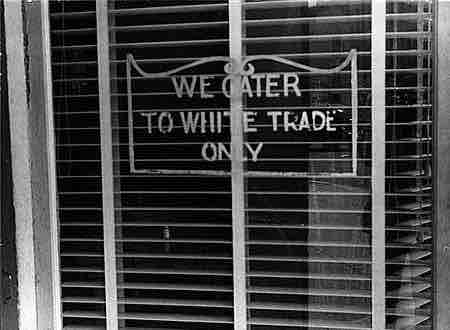Separate but equal was a legal doctrine in American constitutional law that justified systems of segregation. Under this doctrine, services, facilities and public accommodations were allowed to be separated by race on the condition that the quality of each group's public facilities was to remain equal.

Segregation
A store catering to "whites only" under the separate but equal doctrine.
After the end of Reconstruction in 1877, former slave-holding states enacted various laws to undermine the equal treatment of African Americans, although the 14th Amendment, as well as federal Civil Rights laws enacted after the Civil War, were meant to guarantee such treatment. Southern states contended that the requirement of equality could be met in a manner that kept the races separate. Furthermore, the state and federal courts tended to reject the pleas by African Americans that their 14th Amendment rights had been violated, arguing that the 14th amendment applied only to federal, not state, citizenship.
The doctrine of "separate but equal" was legitimized in the 1896 Supreme Court case, Plessy v. Ferguson. Homer Plessy, who was of mixed ancestry, claimed that his constitutional rights had been violated when he was forced to move to a "colored's only car" while riding a train. Nonetheless, the Supreme Court ruling "[required] railway companies carrying passengers in their coaches in that State to provide equal, but separate, accommodations for the white and colored races…," establishing the actual term "separate but equal" in the process. After this ruling, not only was "separate but equal" applied to railroad cars, but also schools, voting rights and drinking fountains. Segregated schools were created for students, as long as they followed "separate but equal".
Although the Constitutional doctrine required equality, the facilities and social services offered to African-Americans were almost always of lower quality than those offered to white Americans. For example, many African-American schools received less public funding per student than nearby white schools. In Texas, the state established a state-funded law school for white students without any law school for black students.
The repeal of such laws establishing racial segregation, generally known as Jim Crow laws, was a key focus of the Civil Rights Movement prior to 1954. The doctrine of "separate but equal" was eventually overturned by the Linda Brown v. Board of Education Supreme Court Case in 1954.